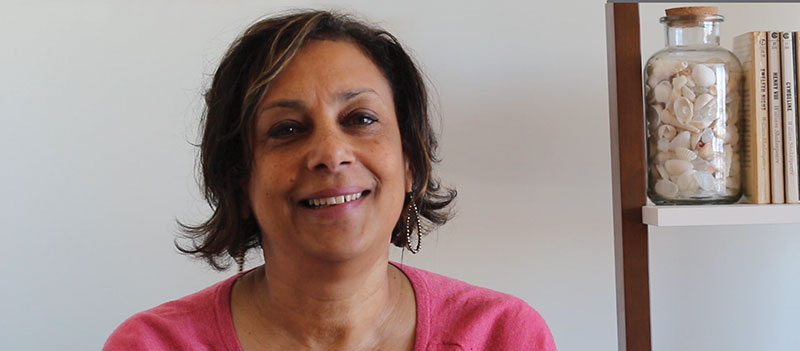The first time Michele Cubelli Harris walked by the Holmes Beverly building, she knew she wanted to live there. She just wasn’t sure if she could afford it.
The six-story apartment complex on Rantoul Street in Beverly, Massachusetts, just blocks from the commuter rail station, looks like a lot of new high-end construction: a sleek gray façade interspersed with brick and large windows. A nice restaurant and supermarket on the ground floor round out its appeal.
Cubelli Harris was looking for a new apartment closer to her job in Lynn. With her kids grown and out of the house, she wanted a home that would be hers alone. She took a picture of the Holmes Beverly leasing sign but worried that, with downtown Beverly becoming a hip place to live, the building was out of her price range. Discouraged, she started looking at apartments on the state affordable housing website instead.

Massachusetts has two categories for housing priced below the market rate. The first, “affordable” housing, is priced so that someone earning 30% to 60% of the area median income could afford to live there; the second category, “workforce” housing, is in the 60% to 120% range of median income.
While the State has focused, understandably so, on creating affordable units to counter the sky-high market rates in the greater Boston area, workforce housing is sometimes called “the missing middle.” There’s a need for more housing for people like Cubelli Harris, whose jobs pay enough to disqualify them for affordable units but who still struggle to find a home that won’t force them to compromise the essentials of a balanced life.
Rarely are units at new developments like Holmes Beverly priced to fit either category. Yet, as Cubelli Harris continued her affordable housing search, she was shocked to see a listing for a unit there.
“Oh my gosh, this can’t be real!” she said to herself.
She immediately emailed the property manager. When she heard back that the building had a single one-bedroom workforce-priced unit available, she was speechless – then asked when she could look at it.
As of last November, that unit is her home – and its benefits resonate through every aspect of her life. Before the pandemic, her commute was sliced down to 20 minutes from more than an hour, so she started her days with more time and enthusiasm. She could walk to meet her friends for dinner nearby. These days, she has created a personal workspace in the apartment and takes long walks on her lunch breaks, sometimes stopping for a coffee or pastry pick up.
And with Beverly so close to the water, she is walking and riding her bike to Dane Street Beach to bask in the sun and take in the sound of the waves.
“I literally felt like I’d won the lottery,” Cubelli Harris said. “It made moving away from home exciting and allowed me to embrace this new stage of my life.”

Finding affordable housing is, unfortunately, a common challenge in Massachusetts. The state is in the middle of a housing crisis, with luxury development outpacing the affordable and workforce units being built. According to the most recent County Health Rankings by the Robert Wood Johnson Foundation, nearly 20 percent of people in Essex County, where Beverly is located, spend over half their income on rent. That leaves little left over for food, medical expenses, childcare, and other necessities.
The 16 workforce housing units at Holmes Beverly were made possible with investment from the Healthy Neighborhoods Equity Fund (HNEF). Created through a partnership between Conservation Law Foundation (CLF) and the Massachusetts Housing Investment Corporation (MHIC), the Fund’s mission is to invest in developments that will have a “quadruple bottom line,” including financial returns as well as positive impacts on the community, environment, and health.
The Fund operates on the core principle that the “environment” isn’t just the beach near Beverly or the state forests west of the city. The environment is everywhere people live, work, and play, and it impacts both individual and community health.
“It’s not that we protect people or the environment – it’s both,” said Maggie Super Church, who leads CLF’s work on the Fund.
Since 2014, HNEF has invested in nine developments in the Greater Boston area. They’re located in Boston neighborhoods as well as smaller cities from Beverly to Braintree. The Fund only invests in projects that are providing new mixed-income housing. Projects with deeper affordability score higher in the review process. To qualify for funding, developers must meet requirements that contribute to a healthy neighborhood, like access to public transit, green space, and a grocery store.
It’s not that we protect people or the environment – it’s both.
Maggie Super Church
For example, transportation forms a key intersection of environment, community, and health: more people riding public transit means fewer people driving cars. Reduced car use, in turn, decreases pollution, improves air quality, and reduces climate-damaging emissions. Fewer cars on the road also makes it safer and more enjoyable for bikers and pedestrians. Whether you’re looking from the perspective of public health, the environment, or city planning, transit-oriented development is a win.
Across all of the Fund’s developments to date, the average walk to public transportation is four minutes. Holmes Beverly is no exception. It’s located near the third-busiest stop on the MBTA commuter rail network, Beverly Depot, which sees an average of 1,382 passengers flowing through every weekday. You can leave the building at 7:30 a.m. and comfortably board the 7:36 a.m. train for the 30-minute ride into Boston.
Holmes Beverly developer Sarah Barnat, who lives in East Boston and is self-avowedly “not a fan of cars,” has focused her career on transit-oriented development. In 2015, she founded her own company, Barnat Development, to build housing that allows residents to live without a car as much as possible. Holmes Beverly was her company’s first project.
“This development enables residents to live car-free in a suburban city,” Barnat said.
Without the Healthy Neighborhoods Equity Fund, however, Holmes Beverly may not have happened at all. Equity investment from the fund provided the development with a financial bedrock, which Barnat called “critical” to its success. That funding, along with a loan from MassHousing, allowed nearly a quarter of the building’s 67 units to be workforce housing, priced for those making 80% to 100% of the median area income. Individually, these workforce-priced units allow Cubelli Harris and others to live in the new development; collectively, they show how impact investments like those from the Fund can prevent buildings like this one from becoming accessible only to the wealthy.
Michele Cubelli Harris grew up in Lawrence and raised her two children in Methuen. She bought her first house as a single mom when she was 27. Lawrence was the place that felt like home, even after her kids grew up and she became an empty nester. But when her job as a Senior Special Program Coordinator with North Shore Community College moved offices from the Danvers campus to the Lynn campus, she found herself bookending her workday with an 80-minute commute each way.
“It really took a toll on me, both mentally and physically,” she said.
The hour-plus drive gave her the final push to make a move. She’d been thinking about it for a while since living alone and had looked at homes in Melrose and Medford, but nothing felt right. Holmes Beverly did
“It was like this move was waiting for me to happen,” she said. “It gives me a fresh perspective, a different outlook. Although it was hard to leave home in Methuen, the move brought me out of an environment that I grew up in and lived all of my life.”
It also gets her into an environment that she wasn’t sure she’d be able to afford to live in.
“Something like this did not seem to be an option to me, in terms of affordability,” she said. “That’s why when I first saw this space, I thought, ‘Careful Michele, don’t get your hopes up.’ I’m a Black woman. I came from Lawrence. I raised my kids on my own. This is an unlikely experience. That is why I decided to participate in this interview: so that more marginalized people, particularly Black people, know that these opportunities do exist and will pursue them.”
It’s an experience that makes buildings like Holmes Beverly, with amenities like a library and a gym, accessible. But it’s the little things that make a difference too. The tile backsplash in her kitchen is her favorite color – navy blue – and just describing it makes her smile.
When she’s not at work, Cubelli Harris can walk out the door to grab dinner. She has more time to spend with friends, many of whom live within walking distance in Beverly.
“It really does give some hope for people like me who grew up in poor neighborhoods, worked hard, got a college degree, but are still not making enough money to live how they might like to,” she said. “This is a wonderful chance.”
Learn more about CLF’s work to support affordable and healthy developments at clf.org/hnef

